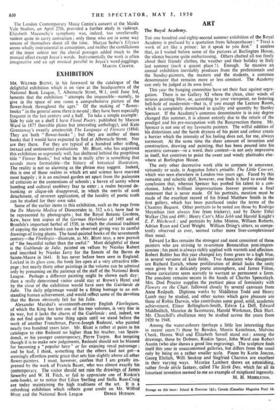ART
The Royal Academy.
THE one hundred and eighty-second summer exhibition of the Royal Academy is prefaced by a quotation from Schopenhauer : " Treat a work of art like a prince : let it speak to you first." I confess that, as I waited before some of the pictures at Burlington House, the silence became quite embarrassing. Others chatted all too freely about their friends' clothes, the weather and their holiday in Italy last summer (such a quaint place !). Enough. So massive an annual exhibition inevitably produces from the professionals and the Sunday-painters, the masters and the students, a common denominator that remains more or less constant. The Academy can only be judged at its own level.
This year the hanging committee have set their face against segre- gation. There is no Gallery XI where the clean, clear winds of serious painting blow, or, according to your viewpoint, no festering hell-hole of modernists—that is, if you except the Lecture Room, which is completely dominated in quality and quantity by Stanley Spencer. If the Academy's common denominator is in any degree changed this summer, it is almost entirely due to the return of the prodigal and his pre-occupation with the Resurrection theme. Mr. Spencer is not one of my favourite painters. The wilful oddities of his distortions and the harsh dryness of his paint and colour create a barrier which the intensity of his feeling does not, for me, always surmount. At the same time the sheer amount of invention and construction, drawing and painting, that has been poured into his eccentric canvases—in a word, their content—is not only impressive in itself, but contrives to point the sweet and windy platitudes else- where at Burlington House.
The only other decorative work able to compete in assurance, virtuosity or scale, is Augustus John's grisaille, The Little Conf.ert, which was seen elsewhere in London two years ago. Faced by this romantic and eclectic idyll, however, one finds it hard to avoid the conclusion that, whereas Spencer has pushed his talent to a con- clusion, John's brilliant improvisations forever promise a final statement that is never made. Of his portraits, mention must be made of the excellent record of his friend Matthew Smith in the first gallery, which has been purchased under the terms of the Chantrey Bequest. Other portraits to be noted are those by Rodrigo Moynihan (not always free from trickery), and by Dame. Ethel Walker (266 and 499) ; Henry Carr's Miss Jebb and Harold Knight's E. F. Hitchcock ; and portraits by John Minton, William Roberts, Adrian Ryan and Carel Weight. William Dring's sitters, as compe- tently observed as ever, seemed rather more liver-complexioned than usual.
Edward Le Bas remains the strongest and most consistent of those painters who are striving to re-animate Bonnardian post-impres- sionism ; his paint is always richly applied with warmth and affection. Robert Buhler has this year changed key from green to a high blue, in several versions of kale fields. Two Associates who disappoint are Richard Eurich, whose proliferation of detail lacks the unity " once given by a delicately poetic atmosphere, and James Fitton, whose caricatures seem scarcely to warrant so permanent a form. The anecdote remains Isecure in the hands of Charles Spencelayh. Mrs. Dod Proctor supplies the prettiest piece of femininity with Flowers on the Chair, followed closely by several canvases from Anne Redpath. Diploma works by Middleton Todd and Henry Lamb may be studied, and other names which gave pleasure are those of Robin Darwin, who contributes some good, solid, academic achievement, Elinor Bellingham-Smith, Edwin La Dell, Edward Middleditch, Maurice de Sausmarez, Harold Workman, Dick Hart. Mr. Churchill's ebullience may be studied across the years from 1920 to 1948.
Among the water-colours (perhaps a little less interesting than in recent years ?) those by Bawden, Morris Kestelman, Malvina Cheek, Hanna Weil arud Elizabeth Sorrell stand out ; among the drawings, those by Dobson, Ruskin Spear, John Ward and Robert Austin (who also shows a good line engraving). The sculpture finds itself this year in unaccustomed galleries, but differs from the usual only by being on a rather smaller scale. Pieces by Karin Jonzen, Georg Ehrlich, Willi Soukop and Siegfried Charoux are excellent in their varying ways. Maurice Lambert shows an astonishing, rather fin-de siècle fantasy, called The Sixth Day, which for all its luxuriant invention seemed to me an example of misplaced ingenuity.
M. H. MIDDLETON.






































 Previous page
Previous page